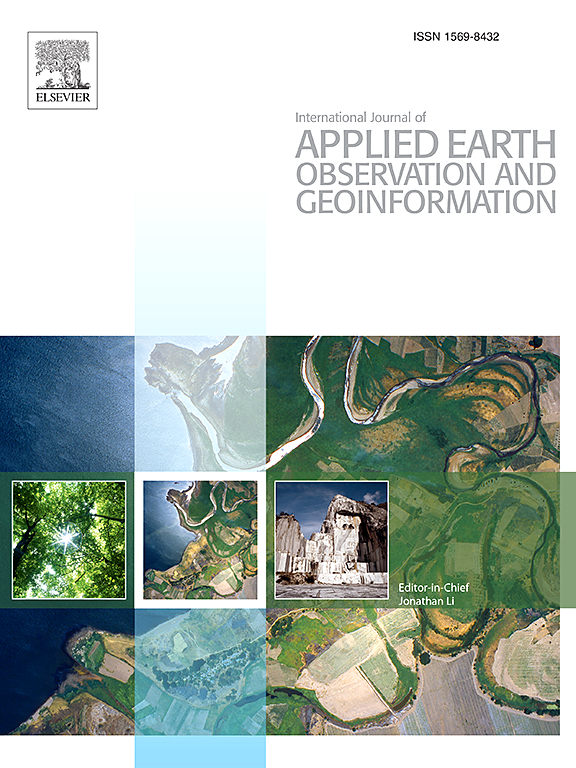用于评估山地森林体积和生物量的高光谱和激光雷达星载数据
IF 8.6
Q1 REMOTE SENSING
International journal of applied earth observation and geoinformation : ITC journal
Pub Date : 2025-06-06
DOI:10.1016/j.jag.2025.104614
引用次数: 0
摘要
准确评估和监测混交林林分体积(SV)和地上生物量(AGB)对可持续林业、生态系统服务评估和减缓气候变化至关重要。虽然机载多/高光谱和激光雷达传感器已被证明对SV和AGB检索有效,但星载系统的潜力仍未得到充分研究。本研究评估了NASA的地表矿物粉尘源调查(EMIT)高光谱数据,结合来自全球生态系统动力学调查(GEDI)激光雷达数据的冠层高度指标,在意大利两个异质山地森林中检索SV和AGB的能力。我们使用五种机器学习(ML)算法:偏最小二乘回归(PLSR)、增强回归树(BRT)、支持向量机(SVM)、人工神经网络(ANN)和高斯过程回归(GPR),将EMIT与Sentinel-2 (S2)多光谱数据作为模型输入进行了比较。然后,我们应用表现最好的模型来生成空间显式的SV和AGB地图。结果表明,与S2-GEDI (R2 = 0.69 RMSE = 84.48 m3 ha - 1, ANN模型)相比,EMIT-GEDI集成提高了SV估计精度(R2 = 0.75 RMSE = 75.48 m3 ha - 1, GPR模型)。与SV模型相比,S2- gedi模型的AGB检索精度明显低于SV模型,而S2- gedi模型的检索精度优于排放物- gedi模型,这可能是因为更高的S2空间分辨率能更好地捕获不同树种的AGB变异。GEDI激光雷达被证明是准确检索SV和AGB的必要输入,GPR是性能最好的ML算法。所得到的空间地图是无人工的,并成功地描绘了生态梯度和管理模式。该研究强调了星载高光谱-激光雷达数据集成在混合山地森林生态系统中用于SV和AGB制图的前景,然而,它也强调了传感器光谱、空间和时间分辨率之间的权衡,因此,即将到来的高光谱任务(如CHIME)将高光谱能力与高空间分辨率和全球尺度的常规数据采集相结合的重要性。本文章由计算机程序翻译,如有差异,请以英文原文为准。

Hyperspectral and LiDAR space-borne data for assessing mountain forest volume and biomass
Accurate assessment and monitoring of stand volume (SV) and above-ground biomass (AGB) in mixed mountain forests is crucial for sustainable forestry, ecosystem service assessment, and climate change mitigation. While airborne multi/hyper-spectral and LiDAR sensors have been proven effective for SV and AGB retrieval, the potential of spaceborne systems remains understudied. This study evaluates the capability of NASA’s Earth Surface Mineral Dust Source Investigation (EMIT) hyperspectral data, combined with canopy height metrics derived from the Global Ecosystem Dynamics Investigation (GEDI) LiDAR data, to retrieve SV and AGB in two heterogeneous mountain forests in Italy. We compared EMIT with Sentinel-2 (S2) multispectral data as model inputs, with and without GEDI data integration, using five Machine Learning (ML) algorithms: Partial Least Squares Regression (PLSR), Boosted Regression Trees (BRT), Support Vector Machines (SVM), Artificial Neural Networks (ANN), and Gaussian Process Regression (GPR). We then applied the top-performing models to generate spatially explicit SV and AGB maps. Results demonstrated that EMIT-GEDI integration enhanced SV estimation accuracy (R2 = 0.75 RMSE = 75.48 m3 ha−1, GPR model) compared to S2-GEDI (R2 = 0.69 RMSE = 84.48 m3 ha−1, ANN model). AGB was retrieved with significantly lower accuracy than SV, and S2-GEDI models outperformed EMIT-GEDI ones, likely because of the higher S2 spatial resolution better capturing AGB variability associated to different tree species. GEDI LiDAR proved to be a necessary input for accurate SV and AGB retrieval, and GPR was the best-performing ML algorithm. The resulting spatial maps were artifact-free and successfully delineated ecological gradients and management patterns. This study underscores the promise of spaceborne hyperspectral-LiDAR data integration for SV and AGB mapping in mixed mountain forest ecosystems, However, it also emphasizes trade-offs between sensor spectral, spatial and temporal resolutions, thus the importance of upcoming hyperspectral missions, such as CHIME, combining hyperspectral capabilities with high spatial resolution and regular data acquisitions at global scale.
求助全文
通过发布文献求助,成功后即可免费获取论文全文。
去求助
来源期刊

International journal of applied earth observation and geoinformation : ITC journal
Global and Planetary Change, Management, Monitoring, Policy and Law, Earth-Surface Processes, Computers in Earth Sciences
CiteScore
12.00
自引率
0.00%
发文量
0
审稿时长
77 days
期刊介绍:
The International Journal of Applied Earth Observation and Geoinformation publishes original papers that utilize earth observation data for natural resource and environmental inventory and management. These data primarily originate from remote sensing platforms, including satellites and aircraft, supplemented by surface and subsurface measurements. Addressing natural resources such as forests, agricultural land, soils, and water, as well as environmental concerns like biodiversity, land degradation, and hazards, the journal explores conceptual and data-driven approaches. It covers geoinformation themes like capturing, databasing, visualization, interpretation, data quality, and spatial uncertainty.
 求助内容:
求助内容: 应助结果提醒方式:
应助结果提醒方式:


